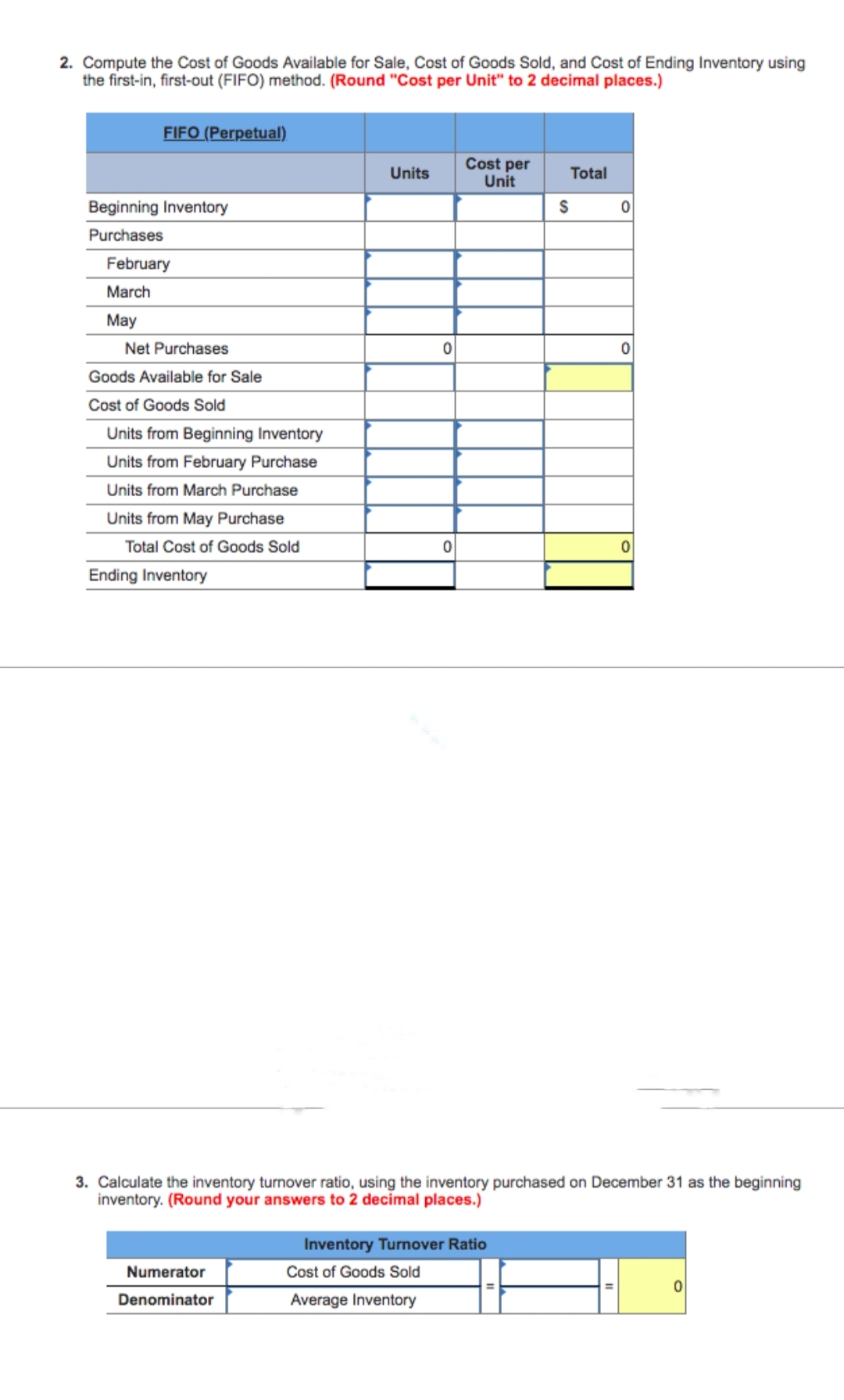In October, Nicole eliminated all existing inventory of cosmetic items. The trouble of ordering and tracking each product line had exceeded the profits earned. In December, a supplier asked her to sell a prepackaged spa kit. Feeling she could manage a single product line, Nicole agreed. Nicole's Getaway Spa (NGS) would make monthly purchases from the supplier at a cost that included production costs and a transportation charge. NGS would keep track of its new inventory using a perpetual inventory system. On December 31, NGS purchased 10 units at a total cost of $7.10 per unit. Nicole purchased 50 more units at $8.70 in February. In March, Nicole purchased 20 units at $10.70 per unit. In May, 60 units were purchased at $10.50 per unit. In June, NGS sold 60 units at a selling price of $12.70 per unit and 50 units at $10.70 per unit.
In October, Nicole eliminated all existing inventory of cosmetic items. The trouble of ordering and tracking each product line had exceeded the profits earned. In December, a supplier asked her to sell a prepackaged spa kit. Feeling she could manage a single product line, Nicole agreed. Nicole's Getaway Spa (NGS) would make monthly purchases from the supplier at a cost that included production costs and a transportation charge. NGS would keep track of its new inventory using a perpetual inventory system. On December 31, NGS purchased 10 units at a total cost of $7.10 per unit. Nicole purchased 50 more units at $8.70 in February. In March, Nicole purchased 20 units at $10.70 per unit. In May, 60 units were purchased at $10.50 per unit. In June, NGS sold 60 units at a selling price of $12.70 per unit and 50 units at $10.70 per unit.
Cornerstones of Cost Management (Cornerstones Series)
4th Edition
ISBN:9781305970663
Author:Don R. Hansen, Maryanne M. Mowen
Publisher:Don R. Hansen, Maryanne M. Mowen
Chapter20: Inventory Management: Economic Order Quantity, Jit, And The Theory Of Constraints
Section: Chapter Questions
Problem 7E: Ottis, Inc., uses 640,000 plastic housing units each year in its production of paper shredders. The...
Related questions
Question
Please do not give solution in image format thanku

Transcribed Image Text:In October, Nicole eliminated all existing inventory of cosmetic items. The trouble of ordering and tracking
each product line had exceeded the profits earned. In December, a supplier asked her to sell a prepackaged
spa kit. Feeling she could manage a single product line, Nicole agreed. Nicole's Getaway Spa (NGS) would
make monthly purchases from the supplier at a cost that included production costs and a transportation
charge. NGS would keep track of its new inventory using a perpetual inventory system.
On December 31, NGS purchased 10 units at a total cost of $7.10 per unit. Nicole purchased 50 more units
at $8.70 in February. In March, Nicole purchased 20 units at $10.70 per unit. In May, 60 units were purchased
at $10.50 per unit. In June, NGS sold 60 units at a selling price of $12.70 per unit and 50 units at $10.70 per
unit.

Transcribed Image Text:2. Compute the Cost of Goods Available for Sale, Cost of Goods Sold, and Cost of Ending Inventory using
the first-in, first-out (FIFO) method. (Round "Cost per Unit" to 2 decimal places.)
FIFO (Perpetual)
Beginning Inventory
Purchases
February
March
May
Net Purchases
Goods Available for Sale
Cost of Goods Sold
Units from Beginning Inventory
Units from February Purchase
Units from March Purchase
Units from May Purchase
Total Cost of Goods Sold
Ending Inventory
Units
Numerator
Denominator
0
0
Cost per
Unit
Total
Inventory Turnover Ratio
Cost of Goods Sold
Average Inventory
S
0
0
3. Calculate the inventory turnover ratio, using the inventory purchased on December 31 as the beginning
inventory. (Round your answers to 2 decimal places.)
0
0
Expert Solution
This question has been solved!
Explore an expertly crafted, step-by-step solution for a thorough understanding of key concepts.
This is a popular solution!
Trending now
This is a popular solution!
Step by step
Solved in 3 steps

Knowledge Booster
Learn more about
Need a deep-dive on the concept behind this application? Look no further. Learn more about this topic, accounting and related others by exploring similar questions and additional content below.Recommended textbooks for you

Cornerstones of Cost Management (Cornerstones Ser…
Accounting
ISBN:
9781305970663
Author:
Don R. Hansen, Maryanne M. Mowen
Publisher:
Cengage Learning

College Accounting (Book Only): A Career Approach
Accounting
ISBN:
9781337280570
Author:
Scott, Cathy J.
Publisher:
South-Western College Pub

Excel Applications for Accounting Principles
Accounting
ISBN:
9781111581565
Author:
Gaylord N. Smith
Publisher:
Cengage Learning

Cornerstones of Cost Management (Cornerstones Ser…
Accounting
ISBN:
9781305970663
Author:
Don R. Hansen, Maryanne M. Mowen
Publisher:
Cengage Learning

College Accounting (Book Only): A Career Approach
Accounting
ISBN:
9781337280570
Author:
Scott, Cathy J.
Publisher:
South-Western College Pub

Excel Applications for Accounting Principles
Accounting
ISBN:
9781111581565
Author:
Gaylord N. Smith
Publisher:
Cengage Learning

Principles of Cost Accounting
Accounting
ISBN:
9781305087408
Author:
Edward J. Vanderbeck, Maria R. Mitchell
Publisher:
Cengage Learning

Managerial Accounting
Accounting
ISBN:
9781337912020
Author:
Carl Warren, Ph.d. Cma William B. Tayler
Publisher:
South-Western College Pub

Financial And Managerial Accounting
Accounting
ISBN:
9781337902663
Author:
WARREN, Carl S.
Publisher:
Cengage Learning,